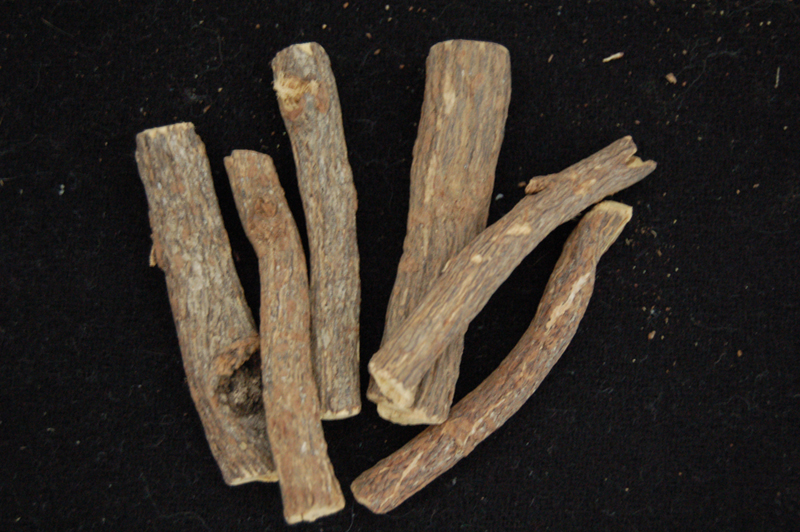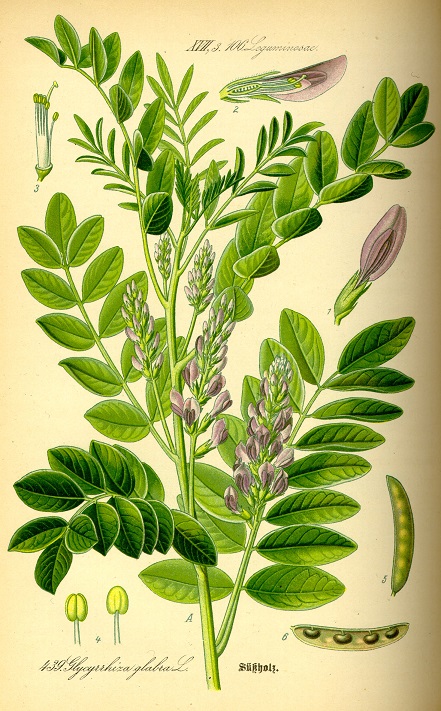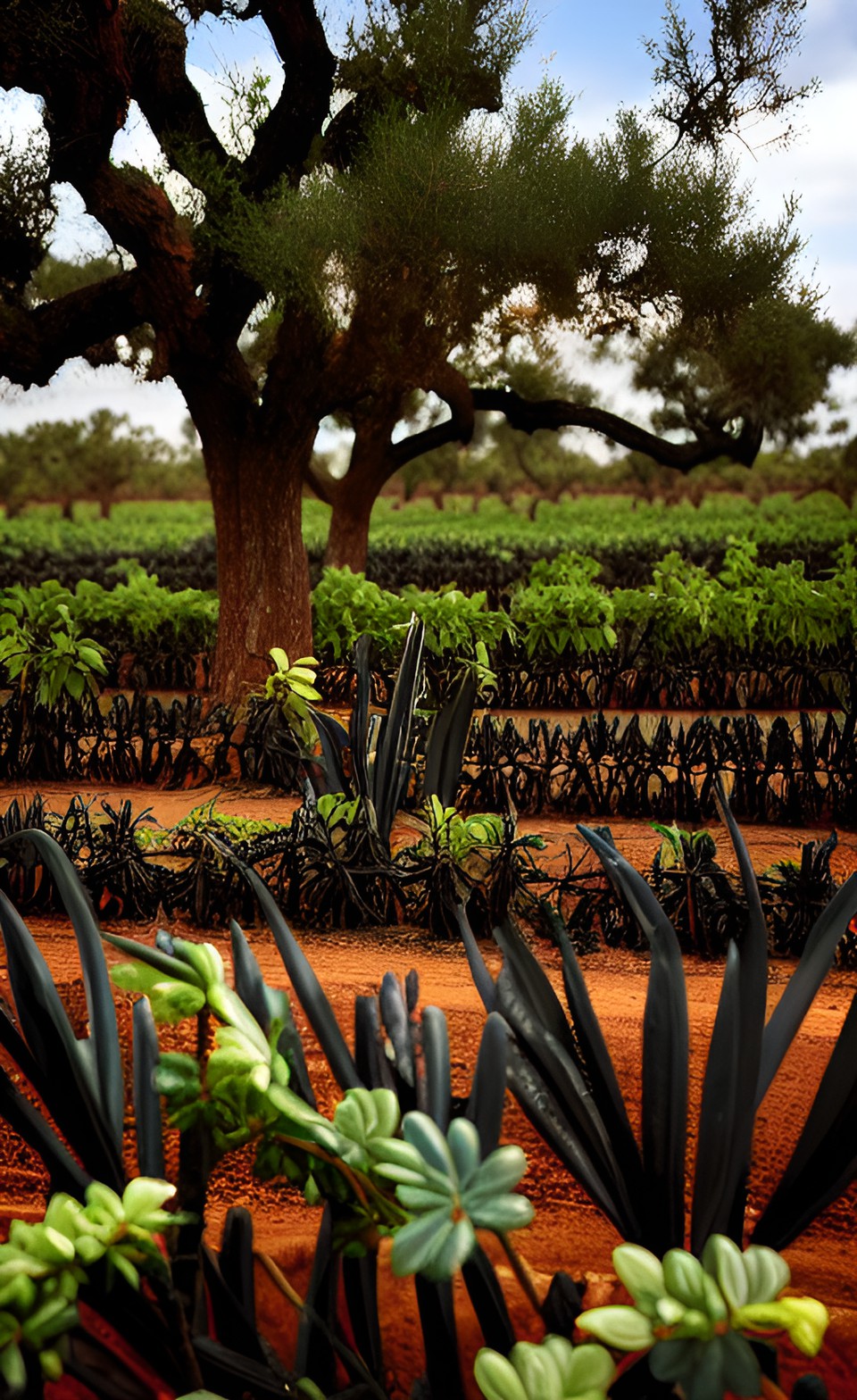Sweetroot
[Glycyrrhiza glandulifer]
Sweetroot (/‘swēt ro͞ot/) is the common name for Glycyrrhiza glandulifera, a low-growing flowering shrub found only in western Noam, eastern Capacyront and northern Barchu. The shrub produces a sour bean which is poisonous. The plant's root, however, is the source of a sweet, aromatic extract which is highly sought after throughout the world, resulting in a thriving commercial market and a robust cultivation and processing industry.
Sweetroot extract has a very strong and distinct aroma, as well as a powerful flavor that is 40 to 50 times sweeter than cane sugar, although unlike cane sugar, sweetroot extract does not cause tooth decay. When ingested orally, it also produces a calming, euphoric effect, and almost immediately triggers a psychological craving that some clinicians have equated with addiction. It is nevertheless almost universally accepted as a food additive. With a current futures price of over §5,000.00/pd., dried sweetroot has long been recognized as the most expensive herbal product in the world.
Sweetroot is considered one of the world's oldest herbal remedies. The plant was first recorded growing on the plains of Podravia as Quizilmiya by ancient Noamese chroniclers in the second century BCS. It later appeared along the western banks of the Pyrat River, where it was called Shirinlik in Old Cyrontian. The Lovasnép call it Édesgyökér, and brought it with them during their eighth century migration into the Barchurian Lowlands, where they introduced it to the valleys of northern Barchuria. Among the Kiltoi it is called Milisfréim.
Dried Sweetroot
CULTIVATION
Sweetroot thrives in well-drained deep valleys with full sun. It takes three to four years for the shrub to mature sufficiently to be harvested. The harvest traditionally takes place in early autumn. Despite numerous attempts, efforts to cultivate the valuable plant outside of its current range have proven utterly fruitless. The oldest and largest producer of raw sweetroot is the Noamese Royal Family, who for centuries have personally owned the monopoly on all sweetroot under cultivation in the country.Harvested sweetroot is first dried, then undergoes a series of mechanical and chemical processes to extract the essential oils from the woody fibers. The oils are then refined to produce a clear liquid extract that is used in a variety of other products. The world's largest producer of sweetroot extract is the Törrhíd company, headquartered in Devola, Barchu.
USES
Sweetroot extract has for centuries been used as an herbal dietary supplement and as a folk remedy for a variety of medical conditions, such as:
Sweetroot extract is also used in shampoos, and as a flavoring in toothpastes, throat lozenges and tobacco products, as well as in candies, confections and beverages.
A wide variety of sweetroot confections and candies are popular around the world. All are produced using a combination of sweetroot extract, cane sugar or molasses, and a binder such as starch, gluten, gum of nemed or gelatin. Amonium chloride can be added to produce a more salty flavor. The ingredients are dissolved in water, heated and then poured into molds. The heating process causes a chemical change in the sweetroot extract that produces a distinctive pitch black color. The liquid is then dried and the resulting treats are sprayed with a thin coat of beeswax to give them their shiny appearance.
In eastern Heremonia, soft sweetroot flavored candybeans are very popular among children and adults alike. In Jarmenic countries, sweetroot flavored hard candies in assorted shapes, called Lakritze, are sold in high volume. In southern Heremonia a saltier version, called Salmiac, is preferred. The most common sweetroot candy consumed in Heberia is in the form of chewy ropes or tubes known as Chikherövs.
stomach inflammation
upper respiratory problems
menopausal symptoms
cough
sore throat
viral and bacterial infections
skin irritations
upper respiratory problems
menopausal symptoms
cough
sore throat
viral and bacterial infections
skin irritations
Sweetroot extract is also used in shampoos, and as a flavoring in toothpastes, throat lozenges and tobacco products, as well as in candies, confections and beverages.
A wide variety of sweetroot confections and candies are popular around the world. All are produced using a combination of sweetroot extract, cane sugar or molasses, and a binder such as starch, gluten, gum of nemed or gelatin. Amonium chloride can be added to produce a more salty flavor. The ingredients are dissolved in water, heated and then poured into molds. The heating process causes a chemical change in the sweetroot extract that produces a distinctive pitch black color. The liquid is then dried and the resulting treats are sprayed with a thin coat of beeswax to give them their shiny appearance.
In eastern Heremonia, soft sweetroot flavored candybeans are very popular among children and adults alike. In Jarmenic countries, sweetroot flavored hard candies in assorted shapes, called Lakritze, are sold in high volume. In southern Heremonia a saltier version, called Salmiac, is preferred. The most common sweetroot candy consumed in Heberia is in the form of chewy ropes or tubes known as Chikherövs.





Comments